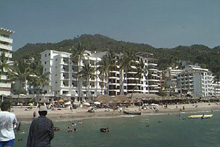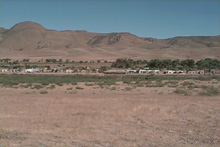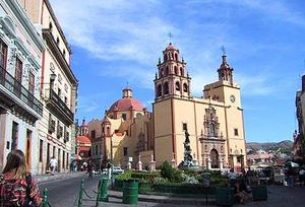Juan Mata Ortíz is a small village of potters, farmers and cowboys in Northern Chihuahua. About 30 years ago, an unschooled artistic genius, Juan Quezada, taught himself how to make earthenware jars in a method used hundreds of years ago by the prehistoric inhabitants. Now, his works are known worldwide and over 300 men, women and children in the village of less than 2000 make decorative wares. Much of the polychrome and blackware is feather light and exquisitely painted.
Many of the potters are also cowboys and farmers. These stories serve to document the art and the people in this unassuming pueblo, which is often called “magical” by the relative handful of tourists who visit. Enjoy this other view of Mexico.
“Mata Ortíz is ruined. It’s spoiled.”
I paused, steaming cup of Nescafe halfway to my mouth. I was sitting in my friend Dora Quezada’s kitchen last October taking coffee with her and a German lady (let’s call her Greta). The tourist was staying with Dora while taking a pottery class with Juan Quezada. It was she who uttered this amazing statement.
“And so is Creel,” she added emphatically. Creel is the gateway to the Copper Canyon (Barranca del Cobre) region of Chihuahua. A poor railway town in the past, it has become a tourist center in recent years, thanks to the continuing growth in popularity of a natural site that dwarfs the amazing Grand Canyon.
“(Pick your site) is ruined” is a statement I often hear about Mexico and it bothers me. Controlling myself, I sipped my metallic tasting brew and decided to work backwards.
“Well, Greta,” I said, ” I was just there last week. I thought Creel was wonderful. Tell me, why is it ruined?”
She explained. “I was there two weeks ago before the class. And I was also there two years ago. It has changed so much. There’s even a Best Western motel!”
I admitted I was a little amused at that myself, but pointed out that the Mexican owner of the motel probably just signed up with Best Western for advertising purposes.
“There are so many tourists there!” Greta protested.
“Greta,” I said gently, “you are a tourist.”
“The main street used to be so quaint, now it is just restaurants and shops.”
“Employment for many people, Greta. How is it ruined?”
We went on in this vein, Greta complaining, me countering. I finally asked what her definition of “quaint” was. I knew the answer before she gave it, because I often ask this question. The answer is always the same. When dissected, “quaint” usually comes out meaning “dirt poor.”
“And how is Mata Ortíz ruined?” I wondered.
Again, stereotypical answers from a Western European/American cultural point of view. “They (the potters of Mata) can’t handle all the money they are now getting.” “All the tourists and traders coming to buy pottery will change their culture forever.” “Look at all the homes with TVs!”
By now our voices were rising. We were speaking in English and poor Dora looked on, perplexed. What were these güeros talking about?
“Greta,” I said, getting up to leave, “Creel and Mata Ortíz are only “ruined” for you. What you consider “spoiled” is progress for the people who count – the people of these communities. They have more employment, real wages, better homes and lifestyles. They are just doing fine, thank you very much.”
I was reminded of this conversation in May when I flew to Puerto Vallarta for a week of R & R. My first trip to PV had been with my parents when I was 13. That was in 1958, before Liz Taylor and Richard Burton arrived. There was no Highway 200, no roads into the village, period. We flew in on a DC-3 and landed on a dirt runway. The town boasted two hotels, the Rosita and the Oceano. The Oceano is now a mass of tourist shops jammed together (and I do regret this) but the Rosita is strong and healthy – celebrating its 50th anniversary this year.

Puerto Vallarta didn’t have a lot of things in those days: no hotels along Playa de los Muertos, no fancy restaurants nor parasailing, none of the trappings of tourism. Want to see Yelapa? Negotiate for a lancha with one of the fishermen after he comes in with the morning catch. No traffic either. One day on horseback, I galloped down the cobbled street along the Malecón to the delight of the locals. I had to dodge neither a bus nor a tourist. My dad and I rode north of PV, along the beaches that today are lined with hotels. Then, nothing but cobalt blue water, golden sand, and emerald jungle. I loved it. Some of my best travel memories are from that first exotic trip. I admit, I miss those days.
But, the “sleepy fishing village” didn’t have other facilities as well. There was an inadequate school which most kids didn’t seem to attend, and if there were a hospital, it couldn’t have been much. In the early mornings, I would watch 100 kilo blocks of chicle, humongous bunches of bananas and sacks of coconuts being hauled down to the beach. The beasts of burden? The backs of local laborers, along with an occasional burro.
When I returned in the mid-60s, I saw many more hotels strewn along the beaches and bigger restaurants clustered in the town center. Tourism was coming. I also witnessed hundreds of little dirty kids taking advantage of this and begging in the streets. Unemployment was still high.
The 1970s, 1980s and this year have seen me return to Puerto Vallarta. I have never grown tired of the town, nor lost my love for it though it continues to change. From first hand experience, I know the public school system is very good, filled with well-dressed, laughing, healthy kids. You don’t find kids begging on the streets any longer.
The hospitals and emergency medical service is also great. One December 12th, at the Festival of Guadalupe, we were jammed into the plaza in front of the iglesia for hours, eagerly awaiting the midnight fireworks. Just as the first balls of light exploded above us, a heavyset American woman near me collapsed. “Pida una ambulancia,” I directed a kid, who eschewed the spectacle he had been patiently waiting for and dashed off. Some abuelas, dressed in the black garb traditionally reserved for older women, gave up their bench for the lady.
In moments the ambulance arrived, the crowd parted without complaint and the American was whisked away. All the while the rockets exploded above us.
I ran into her on the Malecón two days later. She positively gushed about her treatment in the hospital and the quality of the facilities. “I was treated a lot better than I would have been at home!”
Like Greta, people are always telling me that Puerto Vallarta is “ruined” or “spoiled.” No, it is not a sleepy little village anymore – it is a bustling city of over 300,000 full time inhabitants. No, it is not as pristine and hotels have replaced most of the jungle that once insinuated itself into the beach. But it is not ruined; it is improved for the people who count — those who live there. There are schools, a public health system and employment. Sure, there is heavy traffic, but there aren’t beggars.
 Many of us like to vacation or travel in Third World countries. We enjoy the cheaper prices, the sun and (for some of us) the adventure of a different culture. Then, we return to our air conditioning and paved highways feeling slightly superior. We don’t like to see the “quaintness” disappear from our exciting destinations. Then, maybe it’s a little harder to feel superior. Who knows?
Many of us like to vacation or travel in Third World countries. We enjoy the cheaper prices, the sun and (for some of us) the adventure of a different culture. Then, we return to our air conditioning and paved highways feeling slightly superior. We don’t like to see the “quaintness” disappear from our exciting destinations. Then, maybe it’s a little harder to feel superior. Who knows?
People who have exalted in their visits to Mata Ortíz for years tell me they aren’t coming back anymore. “It’s changed too much,” they say. “It’s not the same.” No it’s not, and neither are many places in Mexico. But, change can be good. Thirty years ago, there were only three or four outhouses in Mata Ortíz. Water came from shallow wells, not pipes. Now, it is not uncommon to walk into a house with an indoor bathroom. Most of the potters understand how to handle cash and work in a dollar economy. They invest in improving their homes and purchasing cattle. Yes, the village has lost some of its alleged “quaintness. It’s hard to walk into a home with ceiling fans from Home Depot and “kitchen-by-Sears” and imagine yourself in a quaint environment.
In many places in Mexico we are witnessing people taking advantage of a situation (tourism, folk art, you name it) and pulling themselves up by the bootstraps. They are putting more beans on the table and shoes on the feet of their kids.
We shouldn’t say these areas are ruined. I, too, miss some aspects of the “old days”, but we should celebrate the positive changes. The local people definitely are.

